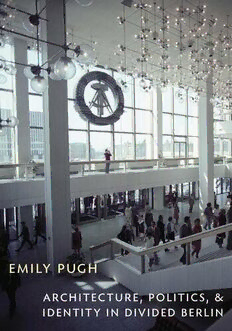
Architecture, Politics, and Identity in Divided Berlin PDF
Preview Architecture, Politics, and Identity in Divided Berlin
Architecture, Politics, & Identity in Divided Berlin Culture, Politics, and the Built Environment Dianne Harris, Editor Emily Pugh Architecture, Politics, & Identity in Divided Berlin University of Pittsburgh Press Published by the University of Pittsburgh Press, Pittsburgh, Pa., 15260 Copyright © 2014, University of Pittsburgh Press All rights reserved Manufactured in the United States of America Printed on acid-free paper 10 9 8 7 6 5 4 3 2 1 Library of Congress Cataloging-in-Publication Data Pugh, Emily. Architecture, Politics, and Identity in Divided Berlin / Emily Pugh. pages cm. — (Culture, Politics, and the Built Environment) Includes bibliographical references and index. isbn 978-0-8229-6302-8 (paperback : acid-free paper) 1. Architecture—Germany—Berlin—History—20th century. 2. Architecture—Political aspects—Germany—Berlin—History— 20th century. 3. Architecture and society—Germany—Berlin—History— 20th century. 4. City planning—Germany—Berlin—History—20th century. 5. Group identity—Germany—Berlin—History—20th century. 6. Germany (West)—Relations—Germany (East) 7. Germany (East)— Relations—Germany (West) 8. Berlin Wall, Berlin, Germany, 1961–1989. 9. Berlin (Germany)—Social conditions—20th century. 10. Berlin (Germany)—Politics and government—1945–1990. I. Title. na1085.p83 2014 720.943'15509045—dc23 2013049108 For Darren Map of Berlin indicating the city’s administrative districts as they appeared until 1990. The grey box is the area detailed by the map of central berlin. Map by Bill Nelson. CONTENTS Acknowledgments ix List of Acronyms xi Introduction: Divided Capital, Dividing Capital 1 1. Modern Capital, Divided Capital: Berlin before the Wall 19 2. A Capital without a Country: Shaping West Berlin’s Image in the Early Cold War 62 3. The Unbridled Buildup of Socialism: Defining and Critiquing Heimat-GDR 106 4. The Dreamed-of GDR: Public Space, Private Space, and National Identity in the Honecker Era 155 5. Capital of the Counterculture: West Berlin and the Changing Divides of the Cold War West 200 6. Back to the Center: Restoring West Berlin’s Image and Identity 241 7. Collapsing Borders: Housing, Berlin’s 750th Anniversary, and the End of the GDR 283 Conclusion: Constructing the Capital of the Berlin Republic 329 Appendix: Governing Entities and Nomenclature, 1949–1989 341 Notes 347 Bibliography 411 Index 435 ACKNOWLEDGMENTS This book would not have been possible without the colleagues, friends, and institutions that supported its creation and completion in myriad ways. I would first like to thank the following institutions that supported travel, research, and the writing of this book: the Center for Advanced Study in the Visual Arts at the National Gallery of Art, the Conference Group on Central European History, the German Historical Institute, the Getty Research Institute, the Graduate Center of the City University of New York, and the IIE Fulbright Program. The book’s publication was supported by a David R. Coffin Publication Grant from the Foundation for Landscape Studies. I would also like to acknowledge those archives that granted me access to their holdings and the individuals at those institutions whose assis- tance and patience were very much appreciated: Heidemarie Bock and Petra Albrecht at the Baukunst Archiv, Akademie der Künste, in Berlin; Andreas Matschenz and Barbara Schäche at the Landesarchiv in Berlin; the very helpful staff at the Filmarchiv of the Akademie der Künste, the Bundesarchiv in Berlin and Koblenz, the Bundesarchiv Filmarchiv, and the Getty Research Institute. Additional research was completed with the kind assistance of the staff members at the Geheimes Staatsarchiv Preußischer Kulturbesitz in Berlin, the Paley Center for Media in New York, the US Na- tional Archives and Records Administration in College Park, MD, and the National Gallery of Art Library, where Jacqueline Protka in particular was instrumental in arranging access to hard-to-find materials. Special thanks to the DEFA Film Library at the University of Massachusetts Amherst, where I screened many of the East German films mentioned in the book. Many thanks also go to Peter Kracht, my editor, and Dianne Harris, series editor, who both supported me and offered much-needed encourage- ment throughout the manuscript’s revision, as well as to the book’s copy editor, Maureen Creamer Bemko. I am also indebted to the anonymous readers whose comments and suggestions helped improve the book manu- script immeasurably. ix
